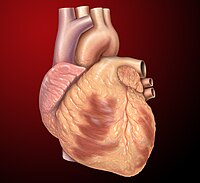
Photo from wikipedia
BACKGROUND A warmup period of "priming" exercise has been shown to improve peripheral oxygen transport in older adults. We sought to determine the acute effects of priming exercise on central… Click to show full abstract
BACKGROUND A warmup period of "priming" exercise has been shown to improve peripheral oxygen transport in older adults. We sought to determine the acute effects of priming exercise on central hemodynamics at rest and during a repeat exercise in heart failure with preserved ejection fraction (HFpEF). METHODS AND RESULTS This is a post-hoc analysis from three studies. Subjects with HFpEF (n=42) underwent cardiac catheterization with simultaneous expired gas analysis at rest and during exercise (20W for 5 minutes, "priming" exercise). Measurements were then repeated at rest and during a second bout of exercise at 20W workload (second exercise). During priming exercise, HFpEF subjects displayed dramatic increases in biventricular filling pressures and exercise-induced pulmonary hypertension. Following priming exercise at rest, biventricular filling pressures and pulmonary artery (PA) pressures were lower and lung tidal volume was increased. During the second bout of exercise, biventricular filling (PA wedge pressure, 29±8 mmHg at 2nd exercise vs. 32±7 mmHg at 1st exercise, p=0.0003) and PA pressures were lower, and PA compliance increased. CONCLUSIONS This study shows that short duration, submaximal priming exercise attenuates the pathologic increases in filling pressures, improving pulmonary vascular hemodynamics at rest and during repeat exercise in HFpEF.
Journal Title: Journal of cardiac failure
Year Published: 2021
Link to full text (if available)
Share on Social Media: Sign Up to like & get
recommendations!